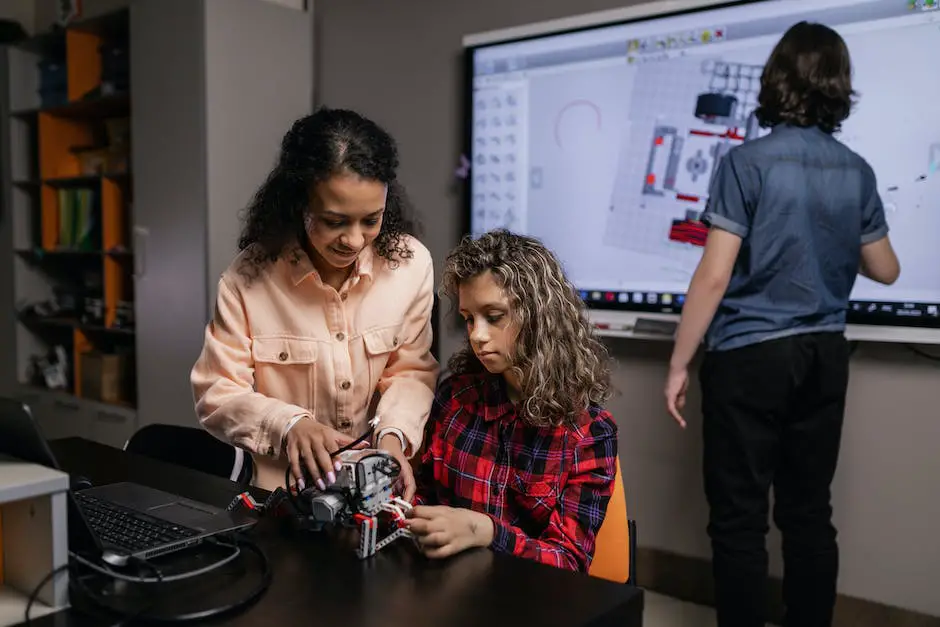As we progress further into the 21st century, the intersectionality between technology and education becomes increasingly imperative to explore and understand. The role of digital tools in facilitating the delivery of education has been transformative and far-reaching, yielding profound implications on teaching modalities, educational parameters, and learner outcomes.
This discourse unfolds the dynamics of such integration, conceptualizing both the potential merits and hurdles of infusing technology into educational systems. It delves deep into various technological forms utilized in education, unravel strategies for successful implementation, and evaluates the far-ranging impacts of these digital tools.
As educators and teachers, this presents an opportunity to both embrace digital evolution and critically identify areas of concern to ensure the equitable and effective incorporation of technology in the educational landscape.
Table of Contents
The Role of Technology in Education
Understanding the Role of Tech in Education
The integration of technology in education is a driving force behind a major shift in how instruction is delivered. Teachers are transitioning from traditional textbook methods to interactive digital formats that engage students more deeply in their learning.
Instructional design now involves creating digital lesson plans which incorporate multimedia elements such as videos, interactive apps and websites, and online quizzes. Teachers can use technology to randomize questions on a quiz, present information in a more visual or interactive way, or offer feedback at the click of a button.
The increasing use of web-based tools and digital platforms has transformed day-to-day teaching and learning. It lends a new degree of flexibility to instruction, delivering content that students can access and interact with at their own pace.
Even beyond formal instruction, technology has made a wealth of educational resources readily accessible. Whether it’s through online tutorials, educational games, or virtual simulations, learning has breached the confines of traditional classrooms and has become a more engaging and immersive experience.
The Impact of Technology on Assessment and Reporting
Technology is greatly reforming educational assessment and outcome reporting. Teachers have at their disposal, a multitude of digital assessment tools that enable them to measure student understanding and proficiency in a myriad of ways. These include online quizzes, games, and simulations which provide immediate results, freeing educators from the extensive paper grading.
Moreover, adaptive testing technologies adjust the difficulty level of questions based on the student’s previous answers, offering an individualized assessment experience.
Continuous and comprehensive student tracking systems, learning management systems (LMS), and other data-driven platforms allow teachers to monitor student progress in real time. This features acute evaluation of student’s understanding of concepts, allowing education facilitators to customize instruction based on individual needs.
Technology Augmentation in Communication and Collaboration
Communication and collaboration have also been influenced majorly by technology. Virtual classrooms have fostered a more in-depth and immediate level of communication between teacher and student. Social media, emails, and collaborative platforms like Google Docs have made it easier to share information, collaborate on projects, and receive class updates.
Educational management systems facilitate teacher-parent communication, enabling parents to keep abreast of their child’s academic progress and behavioral issues more effectively than traditional report cards.
Use of Technology for Educational Research
There has been a vast expansion in the role of technology in educational research. Scholars have access to digital databases, online academic journals, and statistical analysis software all in the aid of advancing educational practices. This makes it vastly easier to review bodies of work connected to research questions, theories, or background information.
Technology has also transformed the methodologies used in research. For instance, digital survey tools and software allow researchers to capture in-depth responses on a large scale in a fraction of the time it would take with traditional paper questionnaires. Similarly, data analysis software enables efficient and complex analysis of data, crucial in research findings.
Summing Up
Technology’s role in education has sparked a significant revamping of traditional education systems. It has revolutionized teaching methods, learning techniques, evaluations, and communication, solidifying its place in contemporary education.
Nonetheless, discussions regarding technology in education extend further than the devices used – they delve into how these tools can enhance student learning and instigate potential advances in education.

Photo by brookecagle on Unsplash
Advantages and Challenges of Technology Integration
The Power of Technology in Education
Integrating technology in education yields numerous perks that enrich academic performance and stimulate learner involvement. For starters, technology gifts access to a plethora of data and digital resources. With the internet, students can delve into an ocean of libraries, databases, and facts that extend far beyond traditional textbooks.
Moreover, technology encourages active engagement and cooperative learning. From interactive whiteboards to educational apps and online collaboration platforms, digital tools enable more hands-on experience and ignite pupils’ enthusiasm. Learners can collaborate on projects, partake in virtual experiments, and have online discussions, honing their analytical thinking and creativity.
Furthermore, differentiated instruction is made possible by technology, catering to the varied learning styles of students. Using digital aids, teachers can adapt their teaching strategies and resources to suit each student’s individual strengths and learning challenges. Multimedia, games, and adaptive learning software are some examples.
Additionally, technology eases the burden of administrative duties, from curating lessons and prep work to tracking pupil progress and parent-teacher communication. For instance, Learning Management Systems streamline the process of assigning, grading, and distributing assignments, freeing up educator’s time for actual teaching or self-improvement.
Finally, in today’s digital age, technology equips learners with skills necessary for the 21st century. By seamlessly integrating technology into classrooms, students are given the opportunity to learn and practice digital citizenship, online research, data interpretation, coding, and other related skills.
Challenges of Technology Integration in Education
Despite these advantages, integrating technology in education also presents several challenges. One of the most pressing issues is inequality in technological access, also known as the digital divide (Dimaggio et al., 2004). Not all students have equal access to digital devices and high-speed internet, which can limit their ability to participate in digital learning and deepen socio-economic disparities.
Students’ over-reliance on technology presents another concern. Technology can sometimes distract learners, leading to decreased attention span (Wilmer et al., 2017) and reduced face-to-face social interaction. If not managed wisely, students might spend too much time on digital devices, leading to negative impacts on health and social skills.
Additionally, integrating technology in education involves a steep learning curve for many educators. They must not only learn how to use new technologies but also how to incorporate them effectively into their teaching strategies. This requires continual education and support, which not all schools can provide.
There is also a risk that technology can substitute instead of enhance teaching. Some educators may depend on technology for instruction rather than using it as a tool to support teaching and learning. This can lead to reduced teaching effectiveness and hinder students’ fundamental understanding of concepts.
Finally, privacy and security risks are associated with the use of technology in classrooms. Schools must ensure the safe and ethical use of digital tools and protect students’ data privacy, necessitating comprehensive technology policies and procedures, which can be complex to establish and maintain.
On the whole, it’s imperative to acknowledge that, while the inclusion of technology in classrooms offers a myriad of advantages, it is crucial to mitigate any challenges that arise. By doing so, we can assure that technology thoroughly fulfills its main objective, which is to enhance student learning and aptly equip them for the intricacies of the digital era.

Exploring Different Technologies in Education
Diving into the Diversity of Digital Tools in Education
The digital revolution has not just modified the global landscape but has also transformed the context of education. Numerous technologies have surfaced as game-changers within the educational field, offering a wide spectrum of tools that can align with an assortment of teaching approaches and learning preferences.
Learning Management Systems (LMS)
Learning Management Systems (LMS) are one such tool that has taken root in the educational sector. These online platforms facilitate the administration, documentation, tracking, reporting, automation, and delivery of tutoring materials.
Teachers can create virtual classrooms on these platforms and assign coursework, provide resources, and engage with students in a consolidated space. Systems such as Blackboard, Moodle, and Canvas are commonly used in educational institutions globally.
LMS not only provides a convenient and organized platform for instruction and learning but also promotes accessibility. Students can access course material, assignments, and grades at any time, from any location with internet access.
Virtual Simulations
Virtual simulations are another technology transforming education. They offer an interactive experience, allowing students to understand complex concepts better. They also provide a safe environment for students to learn from trial and error without any real-world consequences.
For instance, a virtual chemistry lab could allow students to carry out dangerous experiments safely or a history simulation could place students in historic events, enhancing their understanding and retention.
Mobile Applications
Mobile applications have also found their place in education. With the world’s student population significantly owning smart devices, mobile applications offer a method of learning that is both versatile and accessible.
These applications can range from knowledge-based quizzes, subject-specific tutorials to more interactive learning games. Duolingo, Khan Academy, and Quizlet are examples of mobile applications that have gamified education.
Assistive Tech for Special Needs Learners
Technology has also been effective in assisting special needs learners. Assistive technology refers to devices or software used to increase, maintain, or improve the functional capabilities of persons with disabilities.
For instance, text-to-speech software helps students with dyslexia or visual impairment, while alternative input devices aid students with physical disabilities in interacting with computers. Assistive technology can enable students with disabilities to participate more fully in the learning process, facilitating inclusivity in education.
In the realm of education, technology integration is a diverse field, providing a range of tools that are adaptable to various instructional environments.
For us as educators, honing our skills and becoming proficient in these platforms can greatly enrich our teaching strategies, resulting in a more effective and engaging pedagogical process. Mastering these technological advancements is not only necessary in modern educational practices, but also a crucial step in preparing students for an increasingly digital-centric world.

Practical Application: Strategies for Technology Implementation
Comprehensive Planning for Technology Implementation
Implementing a comprehensive strategy is a crucial step in the successful adoption of technology in education. This encompasses setting clear goals, identifying the essential resources, and creating a roadmap to achieve these objectives.
In this scenario, educators should determine explicit aims for incorporating technology into their pedagogical practices. Whether the aim is to boost student involvement, foster individualized learning, or improve the overall classroom experience, these objectives should be Specific, Measurable, Achievable, Relevant, and Time-bound (SMART).
Matching Technologies to Learning Needs
Integrating technology into the teaching process is not merely about using the most advanced tools available. The key is to align the chosen technologies with students’ learning needs. It involves assessing the specific requirements of different learners, identifying gaps in traditional teaching methods, and determining how technology can bridge these gaps.
For instance, a student’s struggle in understanding complex concepts could be addressed by incorporating interactive simulations, virtual reality, or augmented reality into teaching. Conversely, for learners who need additional tutoring, online learning platforms with adaptive learning could be suitable.
Digital Literacy Training for Students
Providing digital literacy training for students is essential when integrating technology into education. With the vast array of digital tools and online resources, students need to acquire skills to use them effectively and safely.
Digital literacy training should not only empower students to navigate digital tools but should also teach them about digital citizenship, including the safe and ethical use of online resources. It includes teaching them about issues such as cyberbullying, plagiarism, and protecting their privacy online.
Monitoring the Use of Technology in Learning
Monitoring the use of technology in learning plays a crucial role in ensuring its effective implementation. It involves keeping track of the way digital tools are used, evaluating their impact on student performance, and making necessary adjustments.
Digital learning platforms often include data analytics tools, which provide valuable insights about student engagement, progress, and areas of difficulty. Teachers can use this data to assess the effectiveness of the technology being used and make adjustments accordingly.
Leveraging Emerging Technologies in Education
The successful integration of technology within educational constructs necessitates an ongoing adjustment and openness towards burgeoning tech trends. It’s crucial for educators to remain in alignment with the latest advancements in edtech, and not hesitate to experiment with novel tools or mechanisms that may enrich their pedagogical repertoire.
This learning progression can be significantly enhanced through active participation in workshops, online teacher groups, tech expos, and professional development programs. It’s integral to fearlessly embrace this continuous tech evolution and to enthusiastically step beyond established comfort zones.
Utilizing these emerging tools and strategies necessitates patience, recognizing that grasping new technologies often comes with a bit of a learning curve for both educators and students.

Evaluating the Impact of Technology in Education
Appreciating the Transformation Brought About by Technology in Education
The dawn of the 21st century heralded a dynamic shift in the implementation of technology within pedagogical practice, morphing traditional teaching frameworks into interactive, engaging learning experiences. A broad range of educational establishments are harnessing the power of digital tools and provisions — from everyday equipment like tablets and laptops, to immersive technologies like augmented reality (AR) and virtual reality (VR) — to enrich and diversify their teaching methodologies.
Popularly known as EdTech, its integration provides multifaceted advantages, including the promotion of improved student interaction, the creation of immersive virtual learning scenarios, robust performance tracking, and tailor-made learning experiences. Numerous studies have demonstrated that these ambitious, tech-enabled approaches have significantly impacted student performance outcomes and the comprehensive quality of education (Zhang, 2022).
Evaluating the Effectiveness of Technology Integration
Numerous studies have been carried out to evaluate the efficiency of technology integration in education and its direct effect on student achievement. For instance, a study conducted by the Center for Research on Education Outcomes (CREDO) at Stanford University concluded that students in online charter schools made significantly larger gains in reading and mathematics compared to their traditional public school counterparts (Richmond, 2022).
Technological advancements, like digital textbooks, educational apps, and online assessment tools, have proven to facilitate innovative teaching methods and promote active learning, which contributes substantially to improved student outcomes.
Statistical Analysis of Educational Technology
Statistically, the integration of technology in education has shown promising results. According to a 2016 report by the Education Week Research Center, three out of four educators reported using technology daily with their students, and most said that edtech helped increase student engagement.
In a more comprehensive study conducted by the U.S. Department of Education (Gray and Lewis, 2021), technology integration in instruction resulted in higher student performance on tests, more student-centered instruction, and increased engagement and motivation among students.
The Future of Technology in Education
The future of technology in education is expected to be characterized by more personalized and student-centric learning experiences. Advanced artificial intelligence (AI) and machine learning algorithms are expected to make learning adaptive, making real-time adjustments based on student behavior and performance.
Virtual and augmented reality technologies offer immersive, experiential learning opportunities that could potentially revolutionize classrooms. High-speed internet connectivity, coupled with VR/AR technologies, could enable real-time global collaborations, expanding the horizons of learning beyond physical classrooms.
Recommendations for Technology Integration
While capitalizing on the advantages of technology integration, it becomes crucial for educators and educational institutions to balance their dependence on tech tools. They should be open to continuous learning and professional development efforts concerning the latest technological updates.
Selecting age-appropriate, reliable, and secure technologies that align with learning goals is pivotal. Also, establishing robust digital infrastructures and promoting digital literacy among students can streamline the transition from traditional to digital education.
Lastly, it’s crucial to frequently assess the effectiveness of technological integration and modify education strategies to ensure continuous improvement in the education standard. Regular feedback from students and teachers can guide necessary updates and improvements in edtech usage.

From this exploration, it is evident that the alignment of technology with education promises a host of opportunities, augmenting pedagogical strategies, engaging learners, and streamlining administrative tasks. However, it also presents an array of challenges such as access inequality and potential over-reliance on gadgets, calling for sustained efforts in strategizing and ensuring equitable tech integration.
As we look forward, the essence lies in continual adaptation alongside these rising digital trends, fostering an educational environment that nurtures technological proficiency without losing the human touch in teaching. Embracing both the potentials and challenges, educators are invited to venture into this digital horizon, to shape and be shaped by this transformative fusion of technology and education.
References
DiMaggio, P., Hargittai, E., Celeste, C., & Shafer, S. (2004). Digital inequality: From unequal access to differentiated use. Social inequality, 355-400.
Gray, L., & Lewis, L. (2021). Use of Educational Technology for Instruction in Public Schools: 2019-20. First Look. NCES 2021-017. National Center for Education Statistics.
Richmond, G. (2022). Choice, Flexibility, Accountability Drive School Improvement: One kind of public school is improving faster than another kind. What explains charter success?. Education Next, 22(2), 36-44.
Wilmer, H. H., Sherman, L. E., & Chein, J. M. (2017). Smartphones and cognition: A review of research exploring the links between mobile technology habits and cognitive functioning. Frontiers in psychology, 8, 605.
Zhang, Y. (2022). The Effect of Educational Technology on EFL Learners’ Self-Efficacy. Frontiers in Psychology, 13, 881301.


